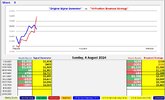- Joined
- 2 April 2024
- Posts
- 91
- Reactions
- 131
This thing is publicly monitored and an inbuild indicator. Now, this is getting funny! What you are coding is an adjusted McD from Alex Springlou (from my memory) So how come this is the same? What do you have for breakfast this morning?@bettamania the Pine Script for the MACD indicator is freely available in TradingView under the indicators section. I’ve already explained the MACD settings, which are the default settings, and the only additions I’ve made are cosmetic to help beginners follow a simple dot system.
TradingView
This software and indicators are freely available here: https://www.tradingview.com/
View attachment 181934
Skate.
Maybe " close enough is good enough'"?




